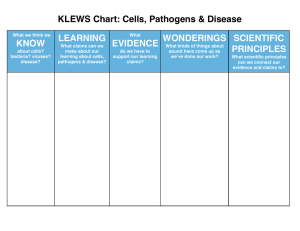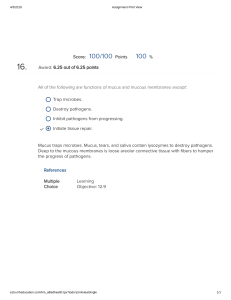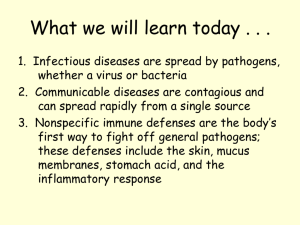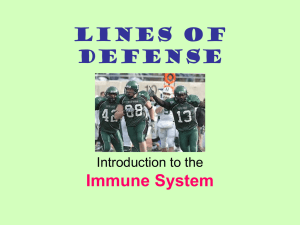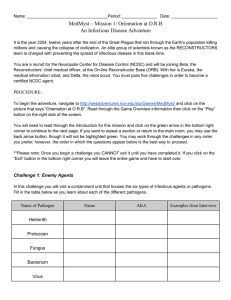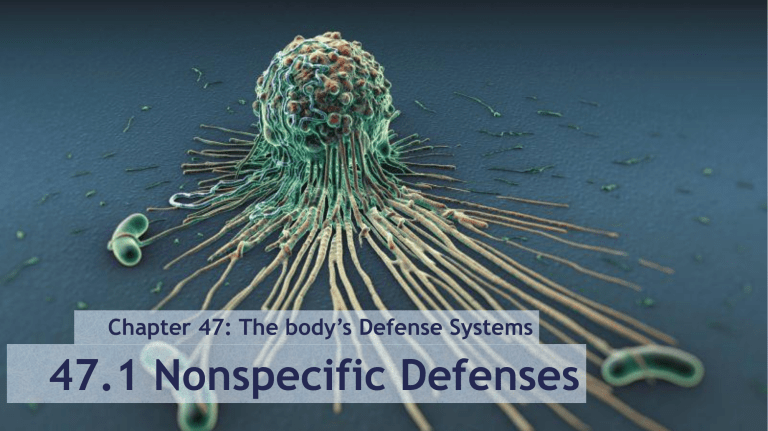
Chapter 47: The body’s Defense Systems 47.1 Nonspecific Defenses Diseases that are caused by agents that have invaded the body are called infectious diseases. Student Objectives 1. 2. 3. 4. 5. Summarize Koch’s postulates for identifying a diseasecausing agent. Describe how the skin and mucous membranes protect the body against pathogens. Describe the steps of the inflammatory response. Analyze the roles of white blood cells in fighting pathogens. Explain the functions of fever and proteins in fighting pathogens. You wake up one morning with a stuffy nose, slight fever, and fatigue. Do you have a cold or the flu? Or are they the same? Should you go to your doctor for an antibiotic? Why or why not? T H I N K I T O U T These are symptoms of some kind of infection. Waking up with these symptoms indicates that some pathogen has entered your body and has triggered an immune response. However, it is not clear whether you have a cold or the flu. Though they are both the result of a viral pathogen, a cold and flu are not the same. You should not see the doctor for an antibiotic because antibiotics are pharmaceutical drugs made to combat bacterial pathogens; they are useless against viruses. Give examples of pathogens that you know. B R A I N S T O R M Identifying Pathogens A pathogen is any agent that causes disease. Robert Koch (1843-1910) was the first person to establish a step-by-step procedure for identifying the particular pathogen that causes an infectious disease. He Studied and isolated anthraxa bacteria born disease which affects cattle. Koch’s postulates are “rules” for determining the cause of the disease. Scientists have used Koch’s postulates to identify thousands of pathogens. Pathogens can spread to human’s in five ways; air, food, water, person-to-person, and bites of animals. Figure 14.3, steps 1–2 Figure 14.3, steps 3–4 Figure 14.3, step 5 First line of Defense: Barriers The body’s nonspecific defenses help protect the body against any pathogens. Nonspecific defenses include the skin and mucous membranes. The skin serves as a physical barrier to pathogens. In addition, the skin releases sweat, oil, and waxes. Mucous membranes are epithelial tissues that protect the interior surfaces of the body. Mucous membranes serve as a barrier and secrete mucus, a sticky fluid that traps pathogens. Second line of Defense: Nonspecific Immunity If a pathogen gets past the skin and the mucous membranes, there is a second line of nonspecific defense inside the body – nonspecific immunity. Nonspecific immunity includes an inflammatory response, the temperature response, and proteins. Inflammatory Response Any pathogen that gets past the skin or mucous membranes will stimulate the inflammatory response, a series of events that suppress infection and speed recovery. 1. Histamine is a substance that increases blood flow to the injured area and increases the permeability of surrounding capillaries. The changes result in redness, swelling, warmth, and pain. 2. Fluids and WBC (phagocytes) pass through capillary wall to the injured area. 3. Phagocytes ingest and destroy pathogens and foreign matter. White Blood Cells The neutrophil is the most abundant type of phagocyte in the body. Neutrophils circulate though blood vessels, and they can squeeze through capillary walls to reach the infection site. They ingest pathogens they may encounter. The macrophage engulf pathogens and cellular debris. Some are stationed in body tissues, while others seek out pathogens. Natural killer cells are large white blood cells that attack pathogeninfected cells. Natural killer cells are effective at killing cancer cells and virus-infected cells. Temperature Response When the body begins to fight pathogens, body temperature may increase several degrees. A rise above the normal temperature (37 ◦C) is called a fever. A fever is a symptom of illness that the body is responding to an infection. A moderate fever may slow bacterial and viral growth and promote white blood cell activity. Proteins Proteins also provide nonspecific response. About 20 different proteins make up the complement system. Complement Proteins circulate in the blood and become active when they encounter certain pathogens. Another nonspecific defense is interferon, a protein released by cells infected with viruses. Interferon causes nearby cells to make a protein that helps them resist viral infection. Review Questions 1. Explain how Koch tested his hypothesis about the cause of anthrax. 2. How does the body’s first line of defense function? 3. What role does greater permeability of capillaries play in the inflammatory response? 4. How do natural killer cells differ from macrophages? 5. What is the role of interferon? 6. Should a fever always be treated? Why or why not? https://www.youtube.com/watch?v=XP-WXLsnMjY
